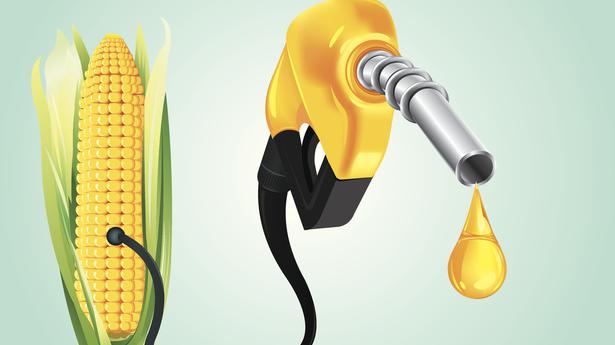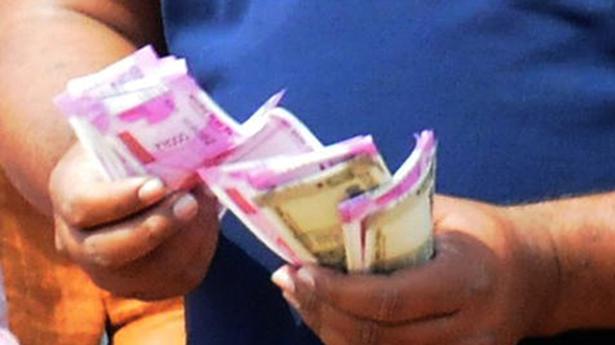Why does the government want to increase the percentage of ethyl alcohol in petrol? From where does India source its ethanol?
Why does the government want to increase the percentage of ethyl alcohol in petrol? From where does India source its ethanol?
The story so far: The Union Cabinet on Wednesday approved amendments to the National Policy on Biofuels, 2018, to advance the date by which fuel companies have to increase the percentage of ethanol in petrol to 20%, from 2030 to 2025. The policy of introducing 20% ethanol is expected to take effect from April 1, 2023.
What is the history of ethanol-blending in India?
Since two decades, India has been moving towards putting in place an ecosystem to have more ethanol blended into petrol for use vehicles, particularly two and four wheelers. Government records suggest about 75% of India’s 220 million vehicles are two wheelers and 12% four wheelers. Ethanol, or ethyl alcohol, is a hydrocarbon that when burnt can generate heat and power engines.
However, it takes much more ethanol to power a vehicle’s engine than petrol. It also leaves residual by-products that can corrode and damage the vehicle which is why, while vehicles can be run on ethanol, they need to be tuned accordingly so that they don’t compromise on efficiency and usability. On the other hand, the gains are potentially significant as ethanol can be sourced from sugarcane, molasses, maize, which given India’s agricultural base, can substantially reduce India’s dependence on petroleum.
Since 2001, India has tested the feasibility of ethanol-blended petrol whereby 5% ethanol blended petrol (95% petrol-5% ethanol) was supplied to retail outlets. In 2002, India launched the Ethanol Blended Petrol (EBP) Programme and began selling 5% ethanol blended petrol in nine States and four Union Territories that was extended to twenty States and four UTs in 2006. Until 2013-14, however, the percentage of blending never crossed 1.5%.
In 2015, the Ministry of Road Transport and Highways notified that E5 [blending 5% ethanol with 95% gasoline] petrol and the rubber and plastic components used in gasoline vehicles produced since 2008 be compatible with the E10 fuel. In 2019, the Ministry notified the E10 fuel [blending 10% ethanol with 90% gasoline]. The rubber and plastic components used in petrol vehicles are currently compatible with E10 fuel. Financial incentives for distilleries coupled with policy support has seen average blending touch 5%. Standards for E20, E85 and even E100 fuel have already been laid. This includes standards for ethanol blended diesel. Since 2020, India has been announcing its intent to achieve 10% blending by the end of 2022 and 20% blending by 2030. The Centre has also targeted 5% blending of biodiesel with diesel by 2030.
What does switching to E20 entail?
A NITI Ayog Committee report of June 2021 lays out a comprehensive picture of ethanol blending, the challenges and a roadmap. India’s net import of petroleum was 185 million tons at a cost of $55 billion in 2020-21. Most of the petroleum is used by vehicles and therefore a successful 20% ethanol blending programme could save the country $4 billion per annum, or about ₹30,000 crore. To achieve such savings, the committee estimates an ethanol demand of 1,016 crore litres based on expected growth in vehicle population. Because electric vehicles are also likely to increase, this should partially offset demand for ethanol leading to a requirement of 722-921 crore litres in 2025.
This however is an “optimistic” projection as the NITI report itself notes. India’s current ethanol production capacity consists of 426 crore litres from molasses-based distilleries, and 258 crore litres from grain-based distilleries. This is expected to increase to 760 crore litres and 740 crore litres respectively and would suffice to produce 1016 crore litres of ethanol required for EBP and 334 crore litres for other uses. This will require six million tonnes of sugar and 16.5 million tonnes of grains per annum in ESY 2025.
How does this affect engines?
When using E20, there is an estimated loss of 6-7% fuel efficiency for four wheelers which are originally designed for E0 and calibrated for E10, 3-4% for two wheelers designed for E0 and calibrated for E10 and 1-2% for four wheelers designed for E10 and calibrated for E20. Car makers have said that with modifications in engines (hardware and tuning), the loss in efficiency due to blended fuel can be reduced. To compensate the consumers for a drop in efficiency from ethanol blended fuels, tax incentives on E10 and E20 fuel may be considered. The test vehicles worked well in several test-situations, the report noted.
What is the international experience?
Flex Fuel Engine technology (FFE), or vehicles that run entirely on ethanol, are popular in Brazil and comprise nearly 80% of the total number of new vehicles sold in 2019. The cost of flex fuel vehicles (four-wheelers) could cost about ₹17,000 to ₹25,000 more than the current generation of vehicles.
The two-wheeled flex fuel vehicles would be costlier by ₹5,000 to ₹12,000 compared to regular petrol vehicles. The global production of fuel ethanol touched 110 billion litres in 2019, or about an average growth of 4% year per year during the last decade. The U.S. and Brazil make up 92 billion litres, or 84% of the global share, followed by European Union (EU), China, India, Canada and Thailand.
The prices of ethanol produced in India are higher compared to U.S. and Brazil, because of the minimum support prices that the government provides.
What are the environmental costs of ethanol blending?
Because ethanol burns more completely than petrol, it avoids emissions such as carbon monoxide. However, tests conducted in India have shown that there is no reduction in nitrous oxides, one of the major environmental pollutants. A report by the Institute for Energy Economics and Financial Analysis (IEEFA) says that for India to meet its target of 20% ethanol blended in petrol by the year 2025, it will need to bring in 30,000 additional sq km of land to come under maize cultivation. Half that land can be used more efficiently to produce clean electricity from solar energy, they contend.
For India, sugarcane is the cheapest source of ethanol. On average, a ton of sugarcane can produce 100 kg of sugar and 70 litres of ethanol but that would mean 1,600 to 2,000 litres of water to produce 1 kg of sugar, implying that a litre of ethanol from sugar requires about 2,860 litres of water.
- The Union Cabinet on Wednesday approved amendments to the National Policy on Biofuels, 2018, to advance the date by which fuel companies have to increase the percentage of ethanol in petrol to 20%, from 2030 to 2025.
- A NITI Ayog Committee report of June 2021 lays out a comprehensive picture of ethanol blending, the challenges and a roadmap.
- Car makers have said that with modifications in engines (hardware and tuning), the loss in efficiency due to blended fuel can be reduced. To compensate the consumers for a drop in efficiency from ethanol blended fuels, tax incentives on E20 fuel may be considered.





